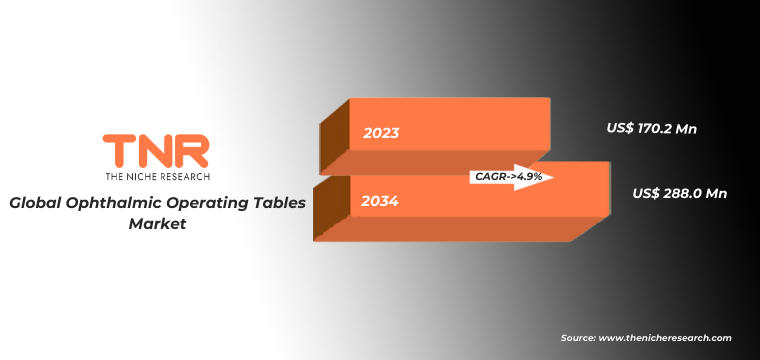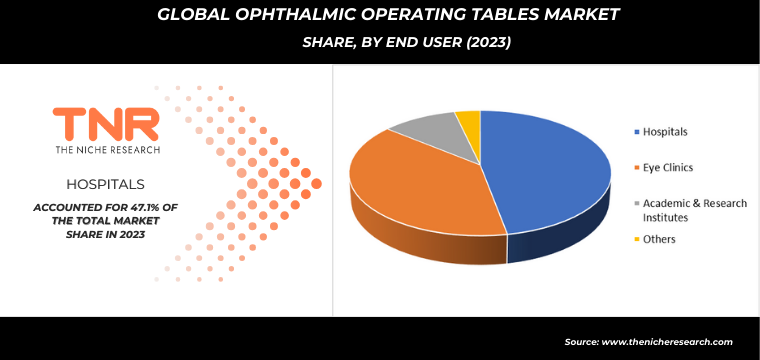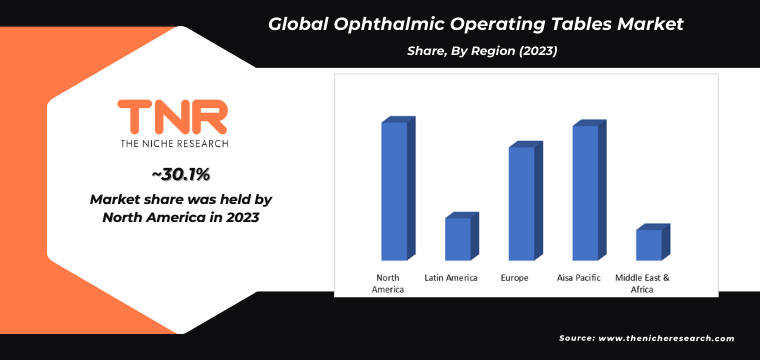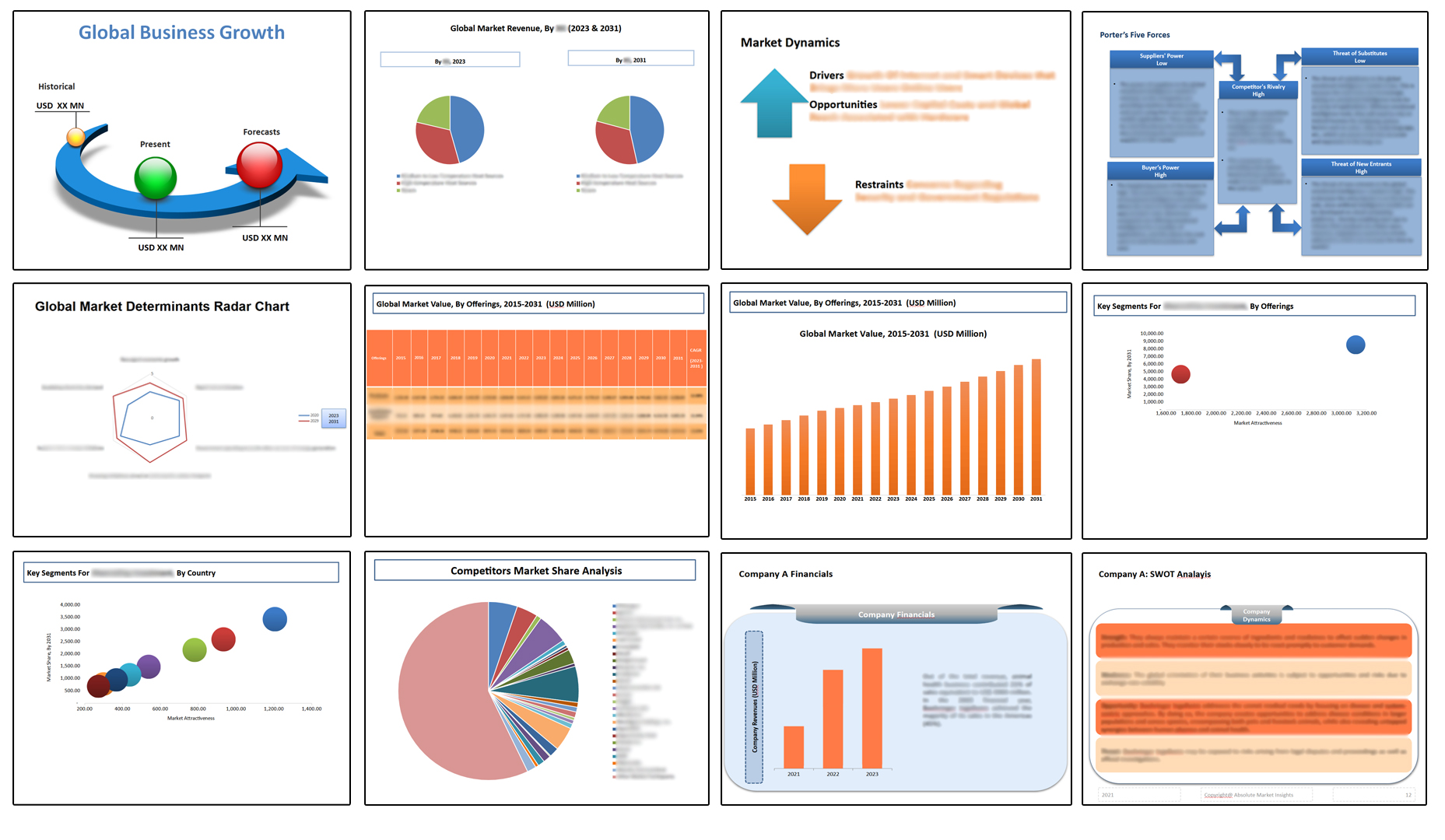Global Ophthalmic Operating Tables Market By Product, By End User, By Region & Segmental Insights Trends and Forecast, 2023 – 2034
- Industry: Healthcare
- Report ID: TNR-110-1057
- Number of Pages: 420
- Table/Charts : Yes
- March, 2024
- Base Year : 2024
- No. of Companies : 10+
- No. of Countries : 29
- Views : 10219
- Covid Impact Covered: Yes
- War Impact Covered: Yes
- Formats : PDF, Excel, PPT
Ophthalmic operating tables market is witnessing substantial growth due to advancements in ophthalmic surgical procedures and rising demand for efficient surgical equipment. These specialized tables are designed to cater to the unique requirements of eye surgeries, providing precise positioning and enhanced access for surgeons. Technological innovations, such as electrically controlled adjustments, improved patient safety features, and integration with imaging systems, contribute to market expansion.
The growing prevalence of eye disorders, coupled with an aging population, drives the demand for ophthalmic surgeries, further propelling market growth. Additionally, increased healthcare infrastructure development and rising investments in medical facilities worldwide foster the adoption of advanced ophthalmic operating tables, shaping a promising landscape for manufacturers and stakeholders in this dynamic market. In terms of revenue, the global ophthalmic operating tables market was worth US$ 170.2 Mn in 2023, anticipated to witness a CAGR of 4.9% During 2024 – 2034.
Global Ophthalmic Operating Tables Market Revenue & Forecast, (US$ Million), 2016 – 2034

Trends in the Global Ophthalmic Operating Tables Market
- Global ophthalmic operating tables market is experiencing a surge in technological advancements, with a focus on digital integration. Tables equipped with advanced imaging systems, robotic assistance, and seamless connectivity are enhancing surgical precision. Surgeons benefit from real-time data, contributing to better decision-making during ophthalmic procedures. This trend underscores the industry’s commitment to cutting-edge solutions that improve patient outcomes and overall surgical efficiency.
- A prominent trend in the ophthalmic operating tables market is the shift towards patient-centric design and ergonomic features. Manufacturers are prioritizing tables that offer optimal positioning for surgeons while ensuring patient comfort and safety. These designs enhance accessibility, reduce procedure times, and contribute to a more positive patient experience. This trend aligns with the growing emphasis on personalized and efficient healthcare solutions, driving the demand for ophthalmic operating tables that prioritize both surgical precision and patient well-being.

Electric operating tables has gained popularity in recent years and is anticipated to be the fastest-growing segment in the global market during the forecast period.
The increasing popularity of electric operating tables in the global market for ophthalmic operating tables is driven by their transformative impact on surgical precision, ease of use, and patient outcomes. Electric tables offer versatile and precise positioning, allowing surgeons to make intricate adjustments with minimal effort. This adaptability is crucial in ophthalmic surgeries where precision is paramount.
Additionally, electric tables enhance workflow efficiency, reducing procedure times and improving overall surgical productivity. The integration of advanced control systems and automation further contributes to the appeal of electric tables, providing surgeons with intuitive interfaces and enhancing overall operational convenience. As healthcare facilities prioritize advanced technologies, the demand for electric operating tables is anticipated to surge, making them the fastest-growing segment in the ophthalmic operating tables market during the forecast period.
 The hospitals segment had the highest share in the global ophthalmic operating tables market in 2023. The dominance of the hospitals segment in the global ophthalmic operating tables market in 2023 can be attributed to several factors. Hospitals serve as primary centers for comprehensive eye care and ophthalmic surgeries, necessitating a robust infrastructure equipped with advanced surgical equipment. Ophthalmic operating tables play a pivotal role in facilitating precise and efficient eye surgeries, and hospitals, being major healthcare institutions, prioritize investing in cutting-edge technologies to enhance patient care.
The hospitals segment had the highest share in the global ophthalmic operating tables market in 2023. The dominance of the hospitals segment in the global ophthalmic operating tables market in 2023 can be attributed to several factors. Hospitals serve as primary centers for comprehensive eye care and ophthalmic surgeries, necessitating a robust infrastructure equipped with advanced surgical equipment. Ophthalmic operating tables play a pivotal role in facilitating precise and efficient eye surgeries, and hospitals, being major healthcare institutions, prioritize investing in cutting-edge technologies to enhance patient care.
Moreover, hospitals often handle a diverse range of ophthalmic procedures, from routine surgeries to complex interventions, requiring versatile operating tables that can accommodate various surgical needs. The high patient influx and the demand for specialized ophthalmic services in hospital settings contribute to the substantial market share. Additionally, the stringent regulatory standards and accreditation requirements for hospitals drive the adoption of advanced equipment, positioning them as key contributors to the global ophthalmic operating tables market share.
Asia Pacific region is poised to experience the fastest growth in the global ophthalmic operating tables market during the forecast period, primarily due to a confluence of factors. Rapid economic development, increasing healthcare infrastructure investments, and a rising prevalence of eye disorders in countries like China and India are propelling the demand for advanced ophthalmic surgical equipment. Additionally, a growing aging population in the region contributes to a higher incidence of age-related eye conditions, fostering the need for sophisticated surgical interventions.
 Moreover, governmental initiatives to improve healthcare accessibility and affordability, coupled with a surge in healthcare expenditure, further drive the adoption of cutting-edge ophthalmic technologies. This combination of demographic trends and supportive healthcare policies positions the Asia Pacific as a key growth engine for the ophthalmic operating tables market in the coming years.
Moreover, governmental initiatives to improve healthcare accessibility and affordability, coupled with a surge in healthcare expenditure, further drive the adoption of cutting-edge ophthalmic technologies. This combination of demographic trends and supportive healthcare policies positions the Asia Pacific as a key growth engine for the ophthalmic operating tables market in the coming years.
Competitive Landscape
The competitive landscape of the ophthalmic operating tables market is characterized by intense rivalry among key players, fostering innovation and strategic collaborations. Market leaders focus on technological advancements, product differentiation, and expanding global footprints to maintain a competitive edge. Robust research and development activities contribute to the dynamic and evolving nature of the industry.
Some of the players operating in the ophthalmic operating tables market are
- Advin Health Care
- Akrus
- Alcon
- ANA MED
- AR EL TIBBI URUNLER
- BENQ Medical Technology
- Bicakcilar
- BiHealthcare
- Ergo Tec
- Frastema
- Gladius Medical KFT
- Howell Medical
- Meditech
- Merivaara
- Ningbo Techart Medical Equipment
- OPT SurgiSystems
- Palakkad Surgical Industries
- Seeuco Electronics Technology
- Shree Hospital Equipments
- Strongman Medline
- Takara Belmont Corporation
- TECHNOMED
- TM Tigers
- UFSK International OSYS
- US Ophthalmic
- Others
Global Ophthalmic Operating Tables Market: Key Takeaways
| Report Specifications | Details |
| Market Revenue in 2023 | US$ 170.2 Mn |
| Market Size Forecast by 2034 | US$ 288.0 Mn |
| Growth Rate (CAGR) | 4.9% |
| Historic Data | 2016 – 2022 |
| Base Year for Estimation | 2023 |
| Forecast Period | 2024 – 2034 |
| Report Inclusions | Market Size & Estimates, Market Dynamics, Competitive Scenario, Trends, Growth Factors, Market Determinants, Key Investment Segmentation, Product/Service/Solutions Benchmarking |
| Segments Covered | By Product, By End User |
| Regions Covered | North America, Europe, Asia Pacific, Middle East & Africa, Latin America |
| Countries Covered | U.S., Canada, Mexico, Rest of North America, France, The UK, Spain, Germany, Italy, Nordic Countries (Denmark, Finland, Iceland, Sweden, Norway), Benelux Union (Belgium, The Netherlands, Luxembourg), Rest of Europe, China, Japan, India, New Zealand, Australia, South Korea, Southeast Asia (Indonesia, Thailand, Malaysia, Singapore, Rest of Southeast Asia), Rest of Asia Pacific, Saudi Arabia, UAE, Egypt, Kuwait, South Africa, Rest of Middle East & Africa, Brazil, Argentina, Rest of Latin America |
| Key Players | Advin Health Care, Akrus, Alcon, ANA MED, AR EL TIBBI URUNLER Turkey, BENQ Medical Technology, Bicakcilar Turkey, BiHealthcare, Ergo Tec, Frastema, Gladius Medical KFT, Howell Medical, Meditech, Merivaara, Ningbo Techart Medical Equipment, OPT SurgiSystems, Palakkad Surgical Industries, Seeuco Electronics Technology, Shree Hospital Equipments, Strongman Medline, Takara Belmont Corporation, TECHNOMED. TM Tigers, UFSK International OSYS, US Ophthalmic, Other Market Participants |
| Customization Scope | Customization allows for the inclusion/modification of content pertaining to geographical regions, countries, and specific market segments. |
| Pricing & Procurement Options | Explore purchase options tailored to your specific research requirements |
| Contact Details | Consult With Our Expert
Japan (Toll-Free): +81 663-386-8111 South Korea (Toll-Free): +82-808- 703-126 Saudi Arabia (Toll-Free): +966 800-850-1643 United Kingdom: +44 753-710-5080 United States: +1 302-232-5106 E-mail: askanexpert@thenicheresearch.com
|
Global Ophthalmic Operating Tables Market Scope
By Product
- Manual Operating Tables
- Hydraulic Operating Tables
- Electric Operating Tables
- Electro-hydraulic Operating Tables
By End User
- Hospitals
- Eye Clinics
- Academic & Research Institutes
- Others
By Region
- North America (U.S., Canada, Mexico, Rest of North America)
- Europe (France, The UK, Spain, Germany, Italy, Nordic Countries (Denmark, Finland, Iceland, Sweden, Norway), Benelux Union (Belgium, The Netherlands, Luxembourg), Rest of Europe)
- Asia Pacific (China, Japan, India, New Zealand, Australia, South Korea, Southeast Asia (Indonesia, Thailand, Malaysia, Singapore, Rest of Southeast Asia), Rest of Asia Pacific)
- Middle East & Africa (Saudi Arabia, UAE, Egypt, Kuwait, South Africa, Rest of Middle East & Africa)
- Latin America (Brazil, Argentina, Rest of Latin America)
Report Coverage

Table of Contents
Note: This ToC is tentative and can be changed according to the research study conducted during the course of report completion.
**Exclusive for Multi-User and Enterprise User.
Global Ophthalmic Operating Tables Market
By Product
- Manual Operating Tables
- Hydraulic Operating Tables
- Electric Operating Tables
- Electro-hydraulic Operating Tables
By End User
- Hospitals
- Eye Clinics
- Academic & Research Institutes
- Others
By Region
- North America (U.S., Canada, Mexico, Rest of North America)
- Europe (France, The UK, Spain, Germany, Italy, Nordic Countries (Denmark, Finland, Iceland, Sweden, Norway), Benelux Union (Belgium, The Netherlands, Luxembourg), Rest of Europe)
- Asia Pacific (China, Japan, India, New Zealand, Australia, South Korea, Southeast Asia (Indonesia, Thailand, Malaysia, Singapore, Rest of Southeast Asia), Rest of Asia Pacific)
- Middle East & Africa (Saudi Arabia, UAE, Egypt, Kuwait, South Africa, Rest of Middle East & Africa)
- Latin America (Brazil, Argentina, Rest of Latin America)
The Niche Research approach encompasses both primary and secondary research methods to provide comprehensive insights. While primary research is the cornerstone of our studies, we also incorporate secondary research sources such as company annual reports, premium industry databases, press releases, industry journals, and white papers.
Within our primary research, we actively engage with various industry stakeholders, conducting paid interviews and surveys. Our meticulous analysis extends to every market participant in major countries, allowing us to thoroughly examine their portfolios, calculate market shares, and segment revenues.
Our data collection primarily focuses on individual countries within our research scope, enabling us to estimate regional market sizes. Typically, we employ a bottom-up approach, meticulously tracking trends in different countries. We analyze growth drivers, constraints, technological innovations, and opportunities for each country, ultimately arriving at regional figures.Our process begins by examining the growth prospects of each country. Building upon these insights, we project growth and trends for the entire region. Finally, we utilize our proprietary model to refine estimations and forecasts.
Our data validation standards are integral to ensuring the reliability and accuracy of our research findings. Here’s a breakdown of our data validation processes and the stakeholders we engage with during our primary research:
- Supply Side Analysis: We initiate a supply side analysis by directly contacting market participants, through telephonic interviews and questionnaires containing both open-ended and close-ended questions. We gather information on their portfolios, segment revenues, developments, and growth strategies.
- Demand Side Analysis: To gain insights into adoption trends and consumer preferences, we reach out to target customers and users (non-vendors). This information forms a vital part of the qualitative analysis section of our reports, covering market dynamics, adoption trends, consumer behavior, spending patterns, and other related aspects.
- Consultant Insights: We tap into the expertise of our partner consultants from around the world to obtain their unique viewpoints and perspectives. Their insights contribute to a well-rounded understanding of the markets under investigation.
- In-House Validation: To ensure data accuracy and reliability, we conduct cross-validation of data points and information through our in-house team of consultants and utilize advanced data modeling tools for thorough verification.
The forecasts we provide are based on a comprehensive assessment of various factors, including:
- Market Trends and Past Performance (Last Five Years): We accurately analyze market trends and performance data from preceding five years to identify historical patterns and understand the market’s evolution.
- Historical Performance and Growth of Market Participants: We assess the historical performance and growth trajectories of key market participants. This analysis provides insights into the competitive landscape and individual company strategies.
- Market Determinants Impact Analysis (Next Eight Years): We conduct a rigorous analysis of the factors that are projected to influence the market over the next eight years. This includes assessing both internal and external determinants that can shape market dynamics.
- Drivers and Challenges for the Forecast Period:Identify the factors expected to drive market growth during the forecast period, as well as the challenges that the industry may face. This analysis aids in deriving an accurate growth rate projection.
- New Acquisitions, Collaborations, or Partnerships: We keep a close watch on any new acquisitions, collaborations, or partnerships within the industry. These developments can have a significant impact on market dynamics and competitiveness.
- Macro and Micro Factors Analysis:A thorough examination of both macro-level factors (e.g., economic trends, regulatory changes) and micro-level factors (e.g., technological advancements, consumer preferences) that may influence the market during the forecast period.
- End-User Sentiment Analysis: To understand the market from the end-user perspective, we conduct sentiment analysis. This involves assessing the sentiment, preferences, and feedback of the end-users, which can provide valuable insights into market trends.
- Perspective of Primary Participants: Insights gathered directly from primary research participants play a crucial role in shaping our forecasts. Their perspectives and experiences provide valuable qualitative data.
- Year-on-Year Growth Trend: We utilize a year-on-year growth trend based on historical market growth and expected future trends. This helps in formulating our growth projections, aligning them with the market’s historical performance.
Research process adopted by TNR involves multiple stages, including data collection, validation, quality checks, and presentation. It’s crucial that the data and information we provide add value to your existing market understanding and expertise. We have also established partnerships with business consulting, research, and survey organizations across regions and globally to collaborate on regional analysis and data validation, ensuring the highest level of accuracy and reliability in our reports.









